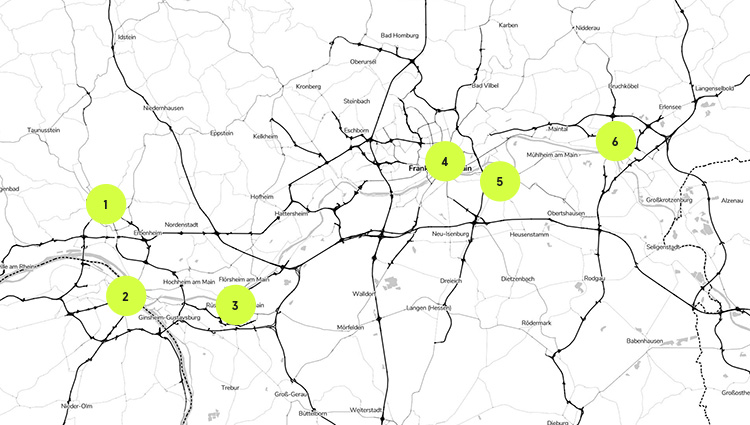
Nassauischer Kunstverein Wiesbaden, Wiesbaden
As a centre for contemporary art in Wiesbaden, the Nassauischer Kunstverein shows and communicates exciting contemporary art and offers young, not yet established artists and cultural workers a field of experimentation and a first stepping stone to a professional career.
One focus of the exhibition activities is the promotion of young, experimental art from Germany and abroad. Both in collaboration with the Kunstverein team and occasionally with guest curators, the Kunstverein offers young artists a platform for their first curatorial practice, a space for current discourse, new perspectives and critical questions. Each exhibition is accompanied by an extensive programme of guided tours, discussions and artist talks.
Station: Wiesbaden main station

The Kunsthalle Mainz is an exhibition house for international contemporary art.
It shows artistic positions that present and convey current issues in art, politics and society. Through a programme of outstanding exhibitions, it sets itself the task of introducing people to art and its themes and establishing Mainz as a permanent location for international art and current discourse.
Station: Mainz main station

Stiftung Opelvillen, Rüsselsheim
The Opelvillen Rüsselsheim show international contemporary and classical modern art. The centre for art is located in the immediate vicinity of the historic fortress on the Main. The ensemble of Opelvillen on the foreland of the Main includes Villa Wenske, the manor house and a newly designed intermediate building. In addition to the exhibition programme, the non-profit institution focuses on the preservation of the buildings, education and outreach as well as the promotion of art.
Station: Rüsselsheim
Museum Angewandte Kunst, Frankfurt
As a lively place of discovery, the Museum Angewandte Kunst focuses on the perception of social trends and developments, with an emphasis on design, fashion and the performative. The changing exhibitions tell of cultural values and changing living conditions. In addition, they always refer to the question of what applied art is and can be today in the field of tension between function and aesthetic added value.
In contrast to traditional collection and classification criteria, the museum does not deal with its objects from their history, but by negotiating contemporary and non-contemporary considerations. This gives rise to questions, which are addressed in thematic exhibitions with ever new constellations of objects.
Station: Frankfurt, Hauptwache
Deutsches Leder Museum, Offenbach
The German Leather Museum has a unique collection of works made of leather and related materials and thus has a unique selling point in the museum world. Recently, the museum has also been opening up specifically to current developments and the holdings of alternative materials have been specifically expanded in recent years to include vegan and recyclable fabrics. More than 30,000 objects bear witness to the global use and diverse cultural-historical significance of leather as a material in different epochs and cultures. On display are footwear from four millennia as well as outstanding ethnographic objects from Africa, Asia, Europe and the Americas as well as polar regions.
Station: Offenbach Ledermuseum
Deutsches Goldschmiedehaus Hanau
Deutsches Goldschmiedehaus in Hanau is one of the most important exhibition centers of gold- and silversmithing art in Germany. The subjects of the versatile exhibitions range from retrospectives of jewellery and hollowware designers to the point of thematic exhibitions, as well as the presentations of different groups of artists and important schools.
Station: Hanau main station

